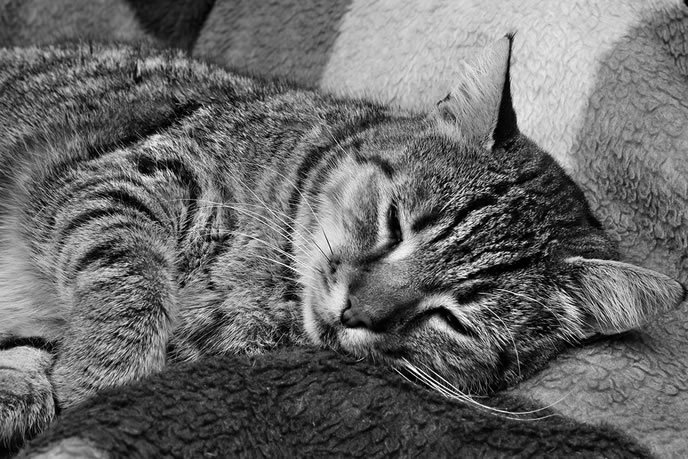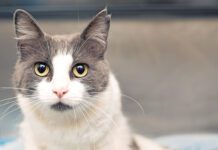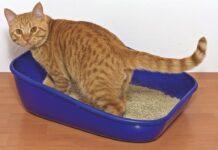If your cat is more than 10 years of age, and you see him arising from a nap in a puddle of urine or with a moist rear, he could have age-related urinary incontinence. The problem, frequently occurring in senior and geriatric cats, has several causes.
Photo: Bigstock

“It often results from urinary bladder or sphincter problems,” says Leni K. Kaplan, DVM, MS, a lecturer in the Community Practice Service at Cornell University College of Veterinary Medicine. “However, incontinence can also be related to anything obstructing urine outflow, such as a tumor or stone. The bladder may then over-distend, and the cat may ‘leak’ if he remains in one place for a while.”
Bacterial bladder infections, or cystitis, can cause an urgent need to urinate. Cats will strain but produce only small amounts of urine, often colored with blood. They can also stop eating and hide because of the pain.
Among other causes of urinary incontinence:
– Feline Lower Urinary Tract Disease, which often has no discernable cause although stress has been cited, as has eating dry food that reduces urine production.
– Other diseases including diabetes, feline leukemia and brain tumors.
– Spinal cord and peripheral nerve problems.
– Arthritis of the back hips or legs, which makes it painful to climb into the litter box and maintain the posture needed to eliminate, thus preventing the bladder from fully emptying.
– Manx, the breed born without tails, can suffer incontinence because of a hereditary spinal malformation.
Sometimes the cause is simpler.
“Geriatric cats sometimes sleep so deeply that they are not awakened by the urge to urinate,” Dr. Kaplan says.
Environment can also play a role. “If aggression from other pets is deterring a cat from using the litter box, where he feels comfortable and not threatened, he may ‘hold it in,’ causing the bladder to overflow when sleeping,” Dr. Kaplan says.
“A cat who is truly incontinent isn’t able to control when and where he leaks. By contrast, inappropriate urination is not typically done where the cat sleeps. The best way to tell is to observe your cat. If he is posturing to urinate intentionally, then he is not incontinent.”
Thorough Testing. A diagnosis of incontinence begins with a history and complete physical exam, including palpation of the urinary bladder. Tests include a urinalysis to detect a bladder infection; a complete blood count to check for systemic infection; a chemistry panel to determine if the kidneys and other organs are functioning normally; and an abdominal X-ray or ultrasound to check for stones or other diseases. If the cat shows neurologic impairment, such as difficulty walking or defecating, other diagnostics may be warranted.
Cats who are incontinent due to poor sphincter control are more prone to urinary tract infections because bacteria can easily ascend into the urinary tract, Dr. Kaplan says. “Twice-yearly urinalysis can ensure that any brewing medical problems are caught early on.” Oral medications can help with sphincter control (phenylpropanolamine or prazosin) and urinary bladder muscle control (bethanechol).
If arthritis pain is a factor, medications can help with that, too. Veterinarians may also offer medications for underlying conditions such as pregabalin for neurologic conditions and opioids such as buprenorphine. And they may administer Adequan (chondroprotectant) injections for joint health. “Acupuncture can be a good treatment modality for incontinence caused by spinal cord or lumbosacral disease,” Dr. Kaplan adds. The efficacy of the latter two treatment options are, at this time, the subject of debate.
If medications aren’t effective or until they take effect, owners can learn how to massage and gently empty the urinary bladder on a schedule, rather than having the distended bladder leak urine, Dr. Kaplan says. “Though this option can help control the leakage, it will not control the underlying cause of incontinence.”
Owners can help their cats by making sure they have easily accessible litter boxes, Dr. Kaplan says. “Keep litter boxes available in different rooms and on different floors of the house. Especially for senior cats, try to help them avoid stairs.”
Skin Issues. Irritated skin is also an issue. “Urine scald can develop as the cat’s skin becomes tender and painful,” Dr. Kaplan says. Application of a diaper rash ointment or petroleum jelly to the area can act as a barrier. Avoid topicals containing zinc, which are toxic to pets. Kitty “diapers” can protect cats from licking topical barriers and also help manage leakage.
Prognosis depends upon the cause of the incontinence and the individual cat’s response to treatment. “I have one feline patient with incontinence following a traumatic event as a youngster,” Dr. Kaplan says. “His owner has learned to express his bladder. The cat has several pairs of ‘piddle pants’ and is on oral medication as well. I’m happy to report that he’s doing great!”


